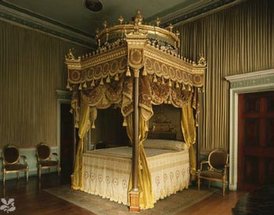

The best place I know to beat the heat in London, especially if you have children in tow, is the Royal Botanic Gardens in Kew. The 300 acre site offers a massive amount of royal and horticultural history, remarkable buildings including a historic palace, the largest collection of plants in the world, manicured gardens and lawns, a play area, and even a herd of sheep and wallabies which have been added to recreate the menageries of Kew’s past.
In many ways, Kew stands as a monument to the British monarchy's love of the great outdoors and it was the royals of the 18th century who took over, expanded and improved what we now think of as Kew Gardens. With the help of architects such as William Chambers and Capability Brown and botanists such as Joseph Banks who sailed with Captain Cook, Princess Augusta and later her son King George III transformed Kew into an exotic horticultural world unto itself.
On a hot day recently, we pitched up at Kew with Eloise and were able to visit two monuments which have been closed to the public for years: the 163 foot high Pagoda and Kew Palace, the former home of King George III.
In 1761, William Chambers, inspired by visits to China, constructed the Pagoda as a surprise for Princess Augusta. How you can keep what some scholars consider the tallest secular brick building of its day a secret, I don’t know. My favourite factoid is that during World War II, holes were cut into each floor through which bomb designers would test their designs.
This summer, for the first time in recent memory, you can climb the 253 steps to the top of the structure. Eloise loved this part of our visit, particularly the extensive health and safety admonishments about what to do if you felt faint, felt chest pains, felt dizzy or generally unwell. The view from the top is nice although London is no New York or Paris from a panorama point of view. Still, the climb was a highlight of our visit.
Equally fun was our time in the newly reopened Kew Palace following a ten year restoration. Originally built by a London merchant, the house was used by the royal family between 1728 and 1818. Today, the intimate palace tells the moving story of King George III, his wife and their 15 children which began in domestic happiness and ended in madness (which we now know was illness) confinement and constitutional crisis. The decorations of the house have been restored to what they would have looked like in the early 1800s and include family memorabilia such as a doll house which the King’s daughters decorated themselves (found recently in a New York City antique store) and George III’s harpsichord.
Hauntingly, the top floor rooms have been left untouched for almost two centuries when the upstairs rooms served as a virtual prison for the King’s unmarried daughters. With Kew Palace, one gets to experience a beautifully restored, historic Royal Palace with a great story and without the crowds one finds at Kensington Palace or Hampton Court.
In addition to the Pagoda and Kew Palace, we also loved our visit to Queen Charlotte’s Cottage, a thatched rustic building which the Queen used for picnics and family retreats. The cottage was originally part of a menagerie which included such exotic animals as kangaroos and buffalo. As we walked around this perfect idyll of rural bliss, I also thought about Marie Antoinette playing shepherdess at the Petite Trianon and the craving of royals to pretend they are peasants. Eloise couldn’t be bothered with this but she did think it was an excellent idea to build a whole house just for picnics.
No visit to Kew would be complete without a “whip round” the glass houses which are justifiably famous and quite spectacular. In the Temperate House, you will find the Chilean Wine Palm which is over 16m high and is the world’s largest indoor plant. The Palm House recreates conditions similar to a tropical rainforest and in the Princess of Wales conservatory you can visit 10 different climatic zones. I’m not much of a botanist but I found the sheer scale of Kew’s collections exciting.
There are several restaurants within the Gardens. We had a snack at The Orangery Café and Restaurant found in a lovely Grade I building with a fine terrace for dining on a nice day. The Orangery also serves afternoon tea. In the Pavilion by the Pagoda, burned down by suffragettes in 1913 and rebuilt in the 1920s, there is a self-service cafeteria which also has a children’s menu.
As I write this post, our little micro heat wave has broken, Wimbledon has started and so, of course, it is pissing down rain. Equally predictable is the fact that when the tennis folks leave town, the sun will come back out and the temperatures will soar. When they do, I’ll head straight back to Kew.
Kew Gardens
Royal Botanic Gardens Kew
Richmond
Surrey
TW9 3AB
England
Information line: +44 (0)870 751 5179
Admission prices to the Royal Botanic Gardens Kew until 31 October 2006
Adult: £11.75
Concessions: £8.75
Children under 17: Free (but must be accompanied by an adult).
Please note: Admission to Queen Charlotte's Cottage is included in this price.
Admission prices to Kew Palace
Adult: £5.00
Concessions: £4.00
Children (5 - 16 accompanied by an adult): £3.00
Children under 5: Free
(NB: admission ticket to the Kew Gardens must be purchased for access to Kew Palace - for gardens admission prices see above)
Transportation
Take the District Line (Richmond Train) to Kew Gardens station or in summer take a Thames River Boat from Westminster Pier. The journey takes approximately 1 ½ hours and costs £10.50 for adults, £5.25 for children one way with family tickets also available.


